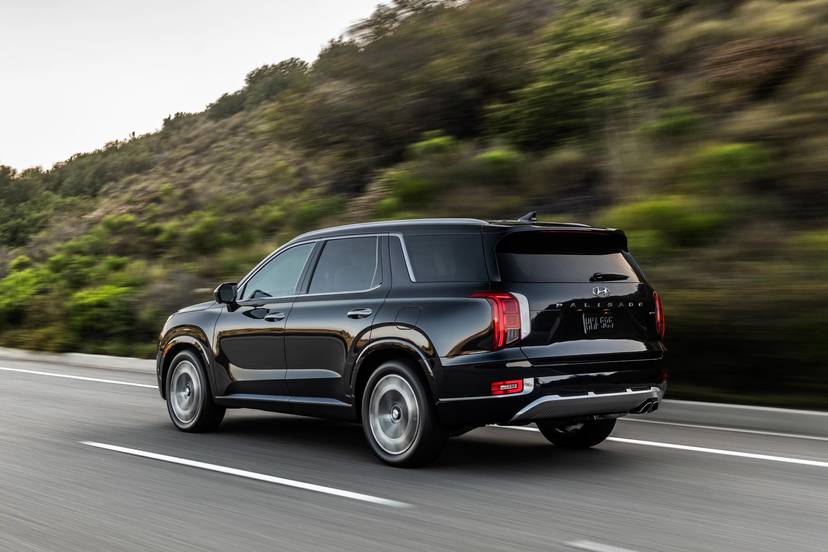
The verdict: The five-seat Hyundai Santa Fe Sport packs undeniable value, but even a raft of updates for 2017 can’t hide spotty cabin quality, practical limitations and other signs of age.
Versus the competition: Largely the same SUV that debuted in early 2012, the Santa Fe Sport is a bargain versus most other midsize SUVs — which have improved a lot since then.
Hyundai says it updated a quarter of the Santa Fe Sport’s parts for 2017, including a number of structural reinforcements to improve its spotty crash-test scores. Freshened styling and an updated multimedia system round out the major changes; you can see all the differences for 2017 here.
The Santa Fe Sport is a smaller version of the three-row Hyundai Santa Fe. With just two rows, the Sport comes in base, 2.0T and 2.0T Ultimate trim levels with two available engines and front- or all-wheel drive. At Cars.com’s 2016 Midsize SUV Challenge, we compared an all-wheel-drive 2.0T Ultimate with four competitors. See more about that here.
We cover the larger Santa Fe separately on Cars.com; compare it with the Sport here.
Exterior & Styling
The visual changes are most prominent up front: The headlights have a little more going on inside the frames, while the fog lights have a lot more going on around the frames. The sum of it all helps differentiate the Sport from the larger Santa Fe, which has its own unique visual updates for 2017.
How It Drives
The Hyundai Santa Fe Sport’s optional 240-horsepower, turbocharged 2.4-liter four-cylinder lends vigorous passing power if you really get on the gas, but it’s a buzzy engine that feels punchiest at higher revs, not off the line. A lag-free accelerator and responsive six-speed automatic help things along, but I’d like more low-rpm power. Despite the engine’s claimed low-end torque, the SUV lacks the immediate thrust of bigger-engine rivals. The three-row Santa Fe has an excellent 3.3-liter V-6 with much better power distribution; Hyundai would do well to pair it with the Sport — you know, to add more sport.
Base models have a 185-hp, non-turbo four-cylinder that makes an EPA-estimated fuel economy of 24 mpg when combined with front-wheel drive. The turbo drops that to 23 mpg. All-wheel drive, available with either engine, loses 1 to 2 mpg depending on configuration. Those figures are competitive with the class and about 1 mpg better fuel economy than the 2016 model thanks to new engine calibrations and a number of other incremental changes.
Ride quality is a touch busy versus other midsize SUVs, but the handling payoff — reasonably flat cornering and decent steering feedback — seems worth it. Our test car had 19-inch alloy wheels, but Hyundai also offers 17- and 18-inchers, either of which might improve ride comfort. Our car’s Kumho Krugen P235/55R19 all-season tires emitted noticeable road noise at highway speeds, but the optional (and enormous) roof rack had little apparent effect on wind noise.
Interior
Largely carried over from the 2013-2016 generation of Hyundai Santa Fe Sport, the cabin is showing its age. The front seats are thin and unsupportive, and the optional leather feels more like vinyl. Cabin quality is all across the board: Some areas are rich while others — grainy grays above the glove compartment, frosted silver on the door handles — seem plucked from an entry-level subcompact. This used to cut it against the previous generation of midsize SUVs, but the class has improved. Hyundai needs to catch up.
Practicality is a mixed bag, too. The rear seats offer myriad adjustments, but the low cushion height will leave taller adults’ knees uncomfortably elevated. The exterior styling sacrifices sight lines, with a rising beltline that diminishes visibility past the B-pillar.
Ergonomics & Electronics
Updated for 2017, the stereo controls are busier now but include both volume and tuning knobs (the latter were absent before). A 5-inch multimedia display (not a touchscreen) and backup camera are now standard. So is satellite radio, plus Bluetooth phone and audio streaming. Upgrade to an optional 7- or 8-inch touchscreen to get Android Auto, Apple CarPlay and HD radio. The 8-inch display adds a navigation system and Infinity premium audio.
Our test car lacked CarPlay, a late addition for the 2017 model year, but Hyundai told us the Santa Fe Sport should offer it now. Shoppers who bought earlier 2017 models with the 7- or 8-inch screen can see their dealer for a free upgrade. You may want to get a few USB car chargers on your way; the Santa Fe Sport has just one USB port.
Cargo & Storage
The center console bin and glove compartment are unremarkable in size, but kudos to Hyundai for putting two storage trays in the center console, including a big one ahead of the gearshift. A surprising number of cars — even SUVs — are stingy with open storage.
Cargo space behind the backseat amounts to 35.4 cubic feet, which is smallish for a midsize SUV. (The Nissan Murano and Ford Edge beat the figure by more than 10 percent.) Fold the seats, and the Santa Fe Sport’s 71.5 cubic feet of maximum room is more competitive with others’ maximum volumes. Hyundai’s standard 40/20/40-split folding rear seat offers a practical advantage to the 60/40-split seats in many rivals, too: You can fit long, narrow cargo, like skis, between two outboard passengers.
Safety
For 2017, Hyundai beefed up the Santa Fe’s cabin structure to improve its performance in the Insurance Institute for Highway Safety’s small overlap front crash test, improving to good (from marginal) in the evaluation. (IIHS scores are poor, marginal, acceptable and good.) With good scores in the agency’s other crash tests, plus a top rating for its optional forward collision warning system with automatic emergency braking, the Santa Fe Sport earned IIHS’ highest designation, Top Safety Pick Plus. See the Santa Fe Sport’s IIHS ratings here and ratings for the rest of the midsize SUV class here.
That said, you’ll have to load up a Hyundai Santa Fe Sport to get that collision warning system. It’s available only on the 2.0T Ultimate, and even then it’s part of a $1,550 option package that includes adaptive headlights with automatic high beams, full speed adaptive cruise control, lane departure warning and a few other features.
Most trim levels have a blind spot warning system. See a full list of standard safety features here and our evaluation of car-seat provisions here. A backup camera is standard, with a 360-degree camera system optional.
Value in Its Class
Front-drive base models start around $26,000 with destination, while an all-wheel-drive 2.0T Ultimate tops out around $40,500 with factory options — an impressive array that includes power front seats with heating and ventilation, heated rear seats, a heated steering wheel, a panoramic moonroof and sunshades for the rear windows.
That’s serious value. The Edge, Murano and Jeep Grand Cherokee all start around $30,000. The Murano tops out past $45,000; the Edge and V-6 Grand Cherokee can spiral into the $50,000s and $60,000s, respectively. Indeed, the Santa Fe Sport’s transaction prices are among the lowest of any midsize SUV, with an excellent warranty and track record of above-average reliability to boot.
Still, the savings come with problems. From cabin materials and visibility to a turbo engine that’s short on low-end grunt, the Hyundai Santa Fe Sport has its share of annoyances. Hyundai’s 2017 refresh fixed the old model’s one deal-breaker — crash tests — but against today’s competition, the Santa Fe Sport still feels old. Until a full redesign, it may not appeal on much more than value.
| Send Kelsey an email |










































